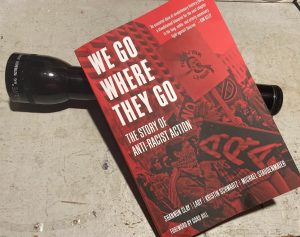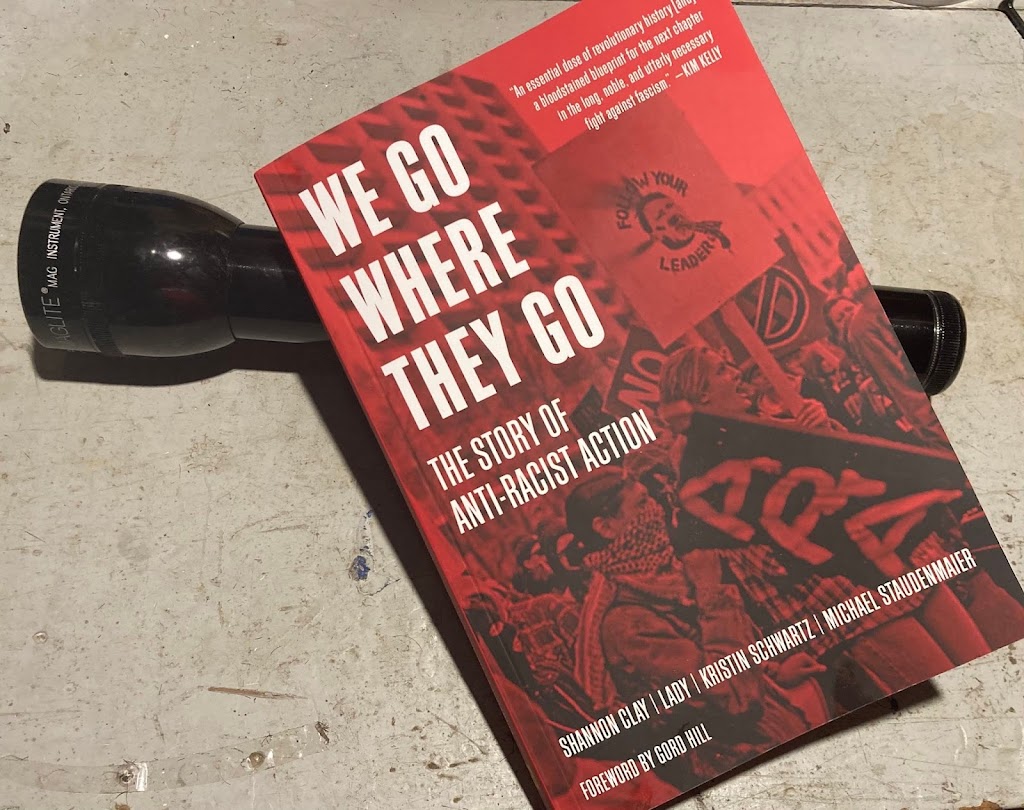Kdog reviews the new book, We Go Where They Go: the Story of Anti-Racist Action
I spent a good part of my teens and twenties building ARA… It was my university… its rewarding to have the history treated as something significant, even crucial. More than giving props to the OG antifas tho—what‘s really meaningful is that this book will help a new generation, confronting new forms of the fascist threat, find inspiration and lessons in both our successes and failures.

In February I read the excellent new book
We Go Where They Go: The Story of Anti-Racist Action written by Shannon Clay, Lady, Kristin Schwartz, and Michael Staudenmaier, with a cool graphic-style Foreword by Gord Hill
—and published by PM Press. This is the first-ever in-depth history of the influential direct-action anti-fascist youth movement
—and the authors do a great job of trying to organize that story into chapters covering the defining struggles and evolutions of the network
—including the turf battles between anti-racist skins and nazi boneheads, the protracted struggle against the Ku Klux Klan’s organizing efforts, ARA ‘s innovative and effective work in Canada, and the fierce opposition to both anti-choice fascists and sexism within our movement. The book is driven by interviews with over 50 ARA veterans, fellow travelers or first-hand observers who provide quotes, reflections, and war stories
—often with a biting sense of humor.
I spent a good part of my teens and twenties building ARA in Minneapolis and St. Paul, Detroit, Chicago and supporting other chapters across North America. It was my university. So it was fun and sometimes emotional to read stories of fights we were in or see quotes from friends who have put in the work and paid their dues in this movement. I always knew that what we did mattered—even if it wasn’t often treated that way by the mainstream left—not to mention broader society. But I have to admit it’s rewarding to have the history treated as something significant, even crucial. More than giving props to the OG antifas tho—what’s really meaningful is that this book will help a new generation, confronting new forms of the fascist threat, find inspiration and lessons in both our successes and failures.
A few things off the top of my head that I thought the book did well were:
1. Quantify the victories against the fash—a surprising number of fascist organizations went out of business after sustained campaigns by ARA—a material contribution to the fight against white supremacy
2. Deal openly and honestly and without hype with the question of political violence—both its efficacy and dangers
3. Emphasize the role of culture (not just the bands—but yes the bands)—the way the movement LIVED and FELT and WORKED
4. Skillfully review the disagreements and controversies within the movement without trying to score points or dismiss points of view
5. Argue for the need for movements that are both militant AND outward facing—radical AND popular
6. Letting the people speak! This isn’t a book of academic citations or leftist rhetoric—it’s the voices of regular, mostly working-class people, mostly without college degrees sharing their thoughtful insights, compelling stories, and clever anecdotes
My criticisms of the book are really more criticisms of ARA. Did we really never articulate a thorough understanding of what fascism is? Or at least establish some solid competing positions? Did we never find a way to talk about strategy beyond the various direct action campaigns we were running? Did we never propose ways to further embed ARA within wider sections of the working-class—and especially relate to communities of color more consistently and systematically? Looking back, some of our short comings are embarrassingly obvious.
For me Anti-Racist Action was a real living example of a genuine
“United Front”—the concept of different groups, tendencies, and individuals working together and having each others’ backs in struggle DESPITE many real and important differences. A United Front does not mean everybody is all happy with each other all the time—quite the opposite, it means we’re all often annoyed, angry or arguing with each other—but we don’t sulk away when we lose a vote or don’t get our way or face some criticism. We do appreciate what other folks are bringing to the table tho, we give them their respect, and we recognize the common goals we are fighting for—because those goals actually fucking matter.
The other thing about ARA I’d like to highlight was the de facto method of leadership—the anarchistic “leadership by example.” Instead of a top-down structure where a few intellectuals dictate strategy and tactics on the larger mass—ARA chapters made their arguments by producing real world examples of what they were talking about. Think we should all do Cop-Watch patrols? Show me what that looks like. Convinced we need to make feminism a core part of our culture? Build a crew that exudes that vibe. Want economic demands as part of the program? See how we are doing it in our town, etc. etc. etc.
I have a lot of love for the hundreds of young people who organized and fought for ARA; for the few elders from the 60s/70s generations who embraced ARA, helped build it and make it more sophisticated; or the bands that saw what we were doing and knew they could help by promoting the work on tour and on records. ARA was a militant movement—we took risks and took licks—and gave em back too. I remember once calculating how many arrests ARA had taken over the years and by my loose tally we were well into the many hundreds when I gave up counting. Many of us got stitches and casts, relationships got tested and burned, and two of us were murdered by nazis in the desert. Now in my 50s I’m still unsettled and angry about a lot—and I’m still active on a few fronts—will be til the day I die. But I have a calmness when I’m around my ARA homies with our jokes, arguments, scars, and PTSD. My people.
Love & Solidarity

